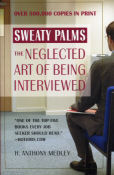| What REALLY goes on in a job interview? Find out in the new revision of "Sweaty Palms: The Neglected Art of Being Interviewed" by Tony Medley, updated for the world of the Internet . Over 500,000 copies in print and the only book on the job interview written by an experienced interviewer, one who has conducted thousands of interviews. This is the truth, not the ivory tower speculations of those who write but have no actual experience. "One of the top five books every job seeker should read," says Hotjobs.com. Click the book to order. Now also available on Kindle. | |
|
The Imitation Game (7/10) by Tony Medley Runtime 114 minutes. OK for children. Alan Turing was a genius who was on the ground floor of the computer revolution, some say he was the father of our computerized world, four decades before his time. He created a machine that could break the German code created by the Enigma machine. In so doing, he created what was probably the first computer. This film tells the story of Turing (Benedict Cumberbatch) and his small coterie of researchers, including Joan Clarke (Keira Knightley) and Hugh Alexander (Matthew Goode), who labored in London’s Bletchley Park during World War II. Directed by Morten Tyldum (a Norwegian who directed the outstanding Headhunters for which he received a 2012 BAFTA nomination) from a script by Graham Moore, based on the book, Alan Turing: The Enigma by Andrew Hodges, it was shot in the short space of eight weeks in England. One location was the former home of James Bond creator Ian Fleming. Unfortunately, the script has some incidents in it of dubious veracity. It purloins the story of Winston Churchill refusing to take action against a German air raid on Coventry in 1940 because to take action would alert the Germans that the British had broken the code, and transfers it to Turing’s group when Turing refuses to warn a convoy it is about to be attacked for the same reason. It’s made more personal because one of Turing’s researchers has a brother on one of the ships in the convoy (what an amazing coincidence!). This clumsy and unnecessary scene lessened the verisimilitude of the film because it was so unlikely to have actually occurred. Another Hollywood ploy is the way Turing finds the key to breaking the code. It’s such a hackneyed “Eureka!” Hollywood moment that it lacks credibility and is an obvious plot device that really isn’t needed. From what I can find out nothing like this actually happened. Hollywood is always looking for that one cinematic moment, but those moments of inspiration rarely exist, reminiscent of Thomas Edison’s comment on finding the solution to the electric light, during which he tried 2,000 times before he found something that would work. There was no “Eureka!” moment. It was, said Edison, “a 2,000 step process.” Hollywood diminishes the time-consuming, detailed work Turing did by putting in moments like this. The acting is very good. Cumberbatch gives a fine performance as a gay man in a country where homosexuality was a crime. Knightley also gives her usual captivating performance, although not much is asked of her. But, even so, she lights up the screen. Goode is also effective. Two technical aspects add immensely to the film. The production design (Maria Djurkovic) and cinematography (Óscar Faura) transpose the audience into the bygone era seven decades ago. This is a good story leading up to what happened to Turing in 1952, seven years after the war ended, and it doesn’t need trite plot devices invented by a screenwriter to make it work.
|
|
|
|
|
